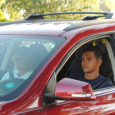You Can Keep Your Teen Drivers Safer. Here are 7 Ways That Can Help

My sons are grown already, safely through the teen years, yet I still remember the scary days when they were teen drivers. If you’re anything like me, your inexperienced teen drivers, or teen passengers who ride with an inexperienced driver, will keep you awake at night until they are safely home.
My sons, Ryan and Randall, were eager to drive but unfortunately for them (or fortunately, depending on your perspective) I had worked in the field of traffic safety for over five years when they were ready to drive. I knew the statistics: On average, every day, six teens die in car crashes while thousands more are injured. One of three killed were passengers and three of four were males. Many were not wearing seat belts.
What I also know is this: Parents play a big role in keeping their teen drivers safe. Teens need rules, practice and a plan for how to handle situations that might lead to a bad or risky decision in a car. That’s where we, as parents, come in.
According to our study, supported by the General Motors Foundation, when parents and teens discuss rules for driving and come to a formal agreement, whether spoken or written, teens are less likely to engage in risky behavior while driving. That’s right, even though we think our teens are not listening or find us boring, they are watching, listening, learning and following our lead.
Here are seven more findings from our research that will help you keep your teenage drivers safe.
- Buckle up, every person, front and back, every ride. One of the best ways to keep teens safe is by using a seat belt – even if they are in the back seat. If you wear a seat belt, your kids are more likely to wear one as well. So if you never did it before, use your seat belt. Every time, every ride.
- Make a family rule: zero tolerance for drinking or impaired driving. There is no safe amount of alcohol a teen can drink before driving. Couple any impairment (it starts with one drink) with their inexperience behind the wheel and you have a recipe for disaster. It is against the law. Make sure you do not drink and drive either. Teens who have seen their parents drink and drive are three times more likely to follow in their footsteps.
- Limit the number of passengers in your teen’s car. The number of passengers, especially if they are male, is directly related to the risk of having a crash. Your state Graduated Driver Licensing law often limits the number of passengers allowed in the inexperienced teen’s car. Learn your law at www.ghsa.org. Make your own “law” if your state does not address this issue.
- Distractions such as texting, talking on the phone and checking email are dangerous for any driver, but especially for inexperienced drivers. Anything that takes the driver’s eyes from the road creates danger for everyone around them. Do you text, talk on the phone or read email while driving? Your teen is following your lead.
- Speeding is a big problem for drivers, especially new drivers. What you do matters, so remember, your teen is watching as you set the example and the rules for your family car. Make sure you follow speed limits.
- Nighttime driving takes some extra experience and skill. Parents need to give their teen plenty of supervised opportunities to practice driving at night and in all kinds of weather and situations. Teen drivers are three times more likely than adults to crash at night.
- Teens need encouragement to speak up if they feel unsafe. Teens told us that they sometimes feel scared, even when they ride with their parents, and they do not know the best way to respond. Help your teens use the right words or have a plan for what to do if they feel unsafe in a car. This is a great scenario to play out in the safety of your kitchen. Give your teen multiple options for getting home safely.
I’m proud to report that it all worked out for my kids. Of course they had some minor scrapes, but they made it through their teenage years without a major crash. And that’s my hope for all parents. Our goal at Safe Kids, much like yours, is to be sure your teen, whether a girl or a boy, is not a statistic and makes it through the most risky years on the road. It takes planning and conviction to be consistent, but trust me, the payoff is worth it.
To help guide your conversation, here is a sample family agreement and you can also check out our interactive infographic on 7 common risks and 7 tips for teen drivers.




